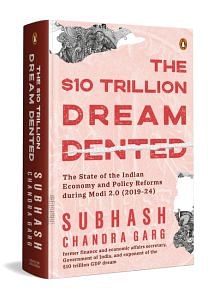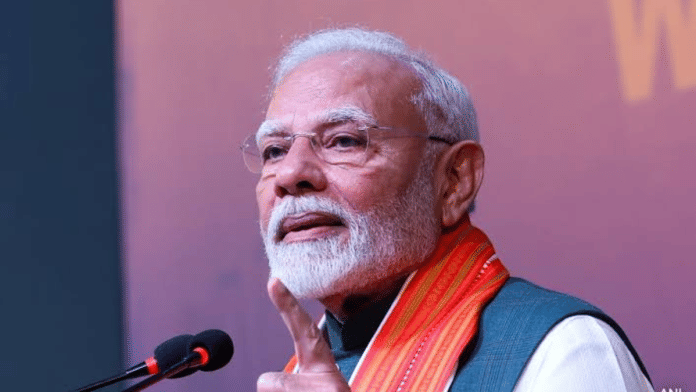The Prime Minister shifted the narrative of New India and Azadi Ka Amrit Mahotsav related to the seventy-five years of India’s independence on 15 August 2022 into Amrit Kaal in his Independence Day speech, though the expression had been in currency for a year or so.
On 1 February 2022, while presenting her 2022–23 Budget, the Finance Minister said, ‘We are marking Azadi Ka Amrit Mahotsav, and have entered into Amrit Kaal, the twenty-five-year-long lead-up to India @100.’ She further stated that the 2022–23 Budget sought to lay the foundation and give a blueprint to steer the economy over the Amrit Kaal of the next twenty-five years ‘from India @75 to India @100’.
In his Independence Day speech on 15 August 2022, the Prime Minister outlined his notion of Amrit Kaal in terms of five resolutions or ‘Panch Pran of Amrit Kaal’. He mentioned the goal of a Developed India among these five resolutions in addition to four others—to remove any trace of the colonial mindset, take pride in our roots, unity and sense of duty among citizens. He further stated that the twenty-five-year Amrit Kaal had started from that day and would culminate on 15 August 2047 with India having become a developed nation.
What defines a Developed India? This was not outlined on 15 August 2022 or explained any time thereafter. Many ministers and governmental institutions have made claims about the size of India’s economy in 2047. Industries and Commerce Minister Piyush Goyal claimed on 20 August 2023 that India’s growth would take the country to a GDP of $35 trillion by 2047. The NITI Aayog chief executive officer, referring to the Centre’s Vision Document under preparation, surmised that India is estimated to be a $30 trillion developed economy by 2047.
India has attained a GDP of $3.56 trillion in 2023–24 and is the fifth-largest economy in the world. With her 140 crore people, India, which has overtaken China, is the most populous country in the world. The per capita income, which measures economic poverty/prosperity of the people, of India is about $2,500, making it languish as one amongst the 140–150 poorest countries of the world.
The global GDP crossed $100 trillion in 2023. With the global population exceeding a little over 8 billion, global average per capita GDP exceeds $12,500. The US, Japan and Germany, three of four countries ahead of us in terms of national GDP, clock average per capita income exceeding $50,000. China, the other country ahead of us, averages $12,500 per capita. India’s per capita GDP is way behind the four countries ahead of us in GDP and is not even 20 per cent of the global average. India will certainly overtake Germany and Japan in the next few years to become the nation with the third-largest GDP in the world when our per capita income GDP would still be below $3,000.
India started out in 1947 as one of the least developed countries (LDC) according to the UN system of development classification. With 80 per cent of her people extremely poor, India got categorized as a low-income country (LIC) in the World Bank’s classification of countries, based on average per capita income. It took India more than fifty years to move out of the class of LICs. To adopt the path to redeem the pledge of becoming a developed nation by 2047, we need to first define our benchmark of a developed nation as there is no globally accepted definition of a developed country.
Breaking into the club of high-income countries (HICs) can be one such indicator. The World Bank threshold for an HIC for 2022–23 is per capita income in excess of $13,845. China is on the verge of getting into the HIC club. It clocked over 8 per cent GDP growth for forty years to attain this milestone when its population growth was also constantly declining. Per capita income of $13,845 is about five to six times India’s current per capita income. Attaining this in 2023 dollars by 2047 looks quite improbable.
With India’s population expected to stabilize around 155–160 crore in 2050, an average per capita income of $10,000 in 2023 dollars will mean a GDP of about $15 trillion. This might be an ambitious and decent goal to consider India a developed nation. The government’s fuzzy notion of Amrit Kaal, without defining what a Developed India would mean in terms of per capita dollar income in 2022/2023 dollars, is not going to take India anywhere. The bigger trouble with these long-term, undefined goals, without intermediate indicators, is that no one can hold the government accountable for making or not making any progress towards the goal.
Such notions are big distractions from the real task of building India and bringing economic prosperity to Indian people. The sooner such vague notions are junked the better.
 This excerpt from ‘The Ten Trillion Dream Dented: The State of the Indian Economy and Reforms in Modi 2.0 (2019-2024)’ has been published with permission from Penguin Random House India.
This excerpt from ‘The Ten Trillion Dream Dented: The State of the Indian Economy and Reforms in Modi 2.0 (2019-2024)’ has been published with permission from Penguin Random House India.






